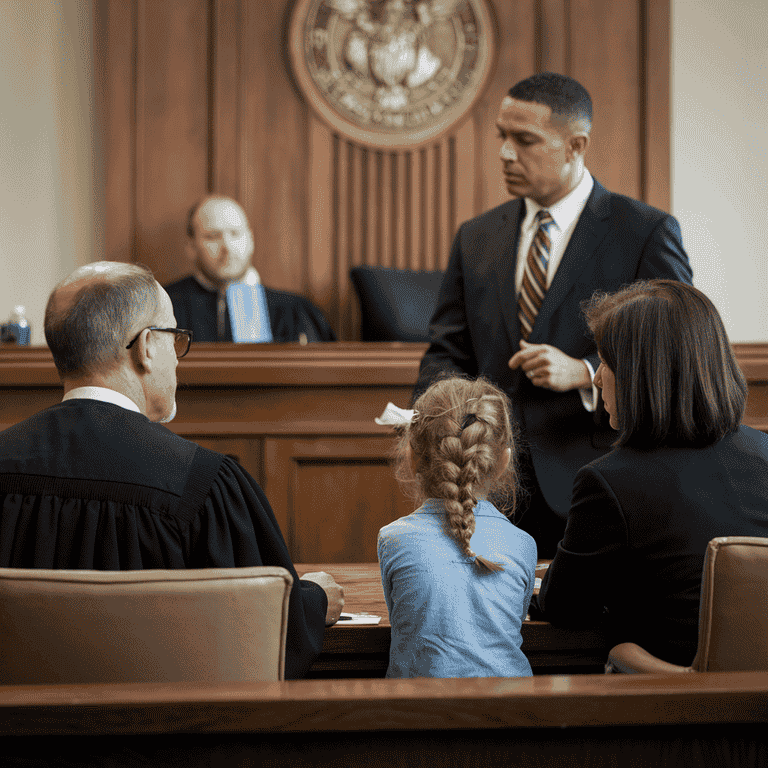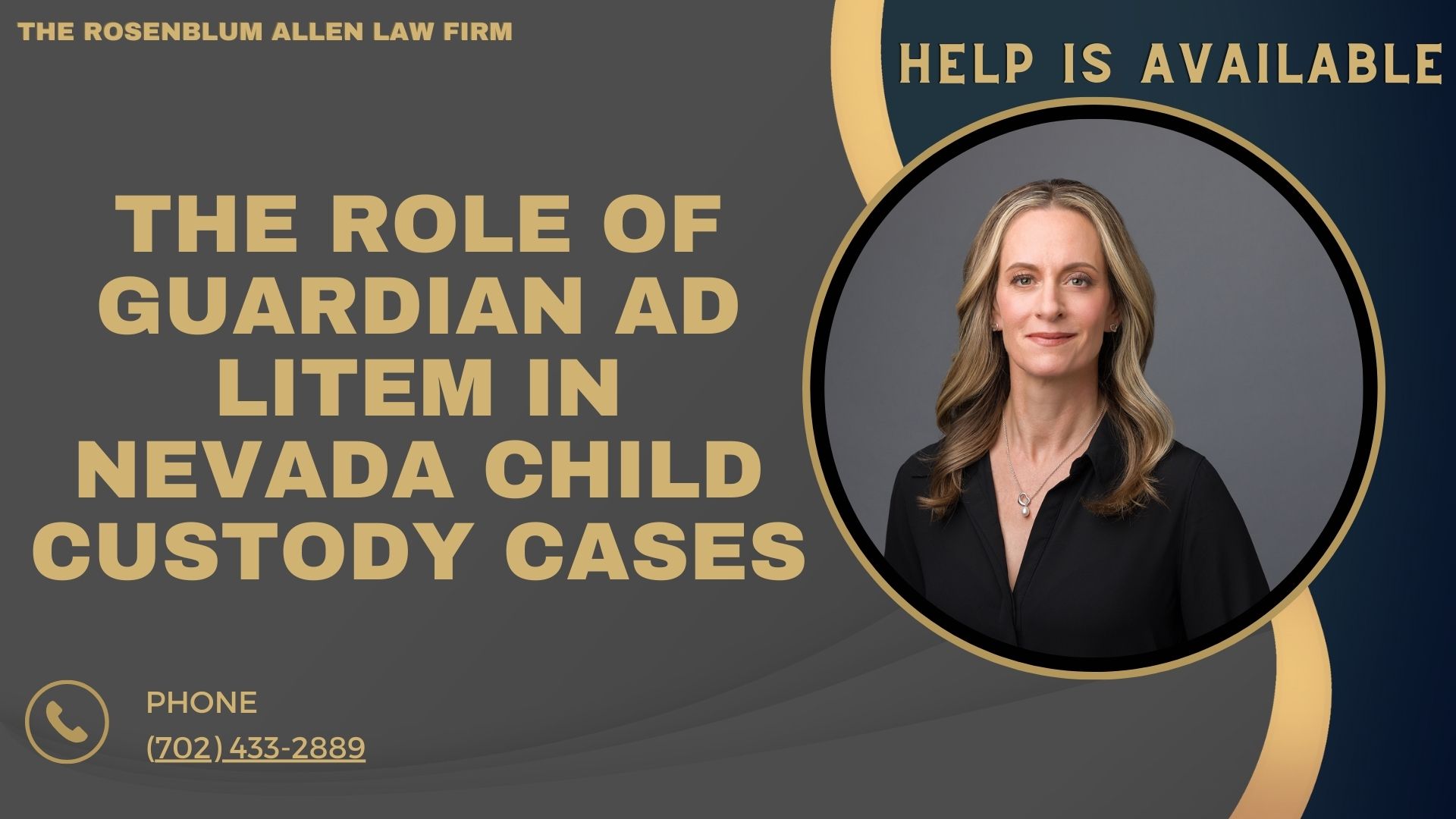Navigating a child custody case in Nevada can be overwhelming, especially when emotions run high, and a child’s best interests are at stake. This is where a guardian ad litem (GAL) steps in. A guardian ad litem is not just another legal figure; they play a unique role in ensuring that the child’s needs and rights are represented in court. In this article, we’ll dive into what a guardian ad litem does, why they are appointed, and how they impact custody decisions in Nevada family courts.
 What is a Guardian ad Litem?
What is a Guardian ad Litem?
A guardian ad litem is a court-appointed advocate specifically designated to represent the best interests of a child during legal disputes, primarily in child custody cases. Unlike attorneys representing the parents, the GAL focuses on what’s best for the child. This role is crucial because children, especially young ones, often cannot express their needs and preferences in a legal setting.
Critical Functions of a Guardian ad Litem
- Investigate: The GAL gathers information about the child’s situation by interviewing parents, caregivers, and others involved in the child’s life.
- Report: They compile their findings into a detailed report that reflects the child’s needs and makes recommendations to the court.
- Advocate: The GAL advocates for the child’s best interests during court proceedings, presenting findings that can influence custody decisions.
When is a Guardian ad Litem Appointed?
Guardians are not automatically involved in every custody case. Instead, they are appointed under specific circumstances where the court believes their input is necessary to protect the child’s welfare.
Common Scenarios for Appointment
- High-Conflict Custody Disputes: When parents cannot agree on custody terms, and disputes become intense, a GAL may be appointed to provide an objective perspective focused on the child’s needs.
- Allegations of Abuse or Neglect: In cases where there are accusations of abuse, neglect, or domestic violence, a GAL helps the court determine what arrangement will best protect the child.
- Special Needs Cases: If a child has unique physical, emotional, or educational needs, a GAL can help ensure that these needs are adequately considered in custody arrangements.
Appointment Process
- Request by a Party: The parent or their attorney can request the appointment of a GAL, usually through a formal motion.
- Court’s Own Motion: Based on the case details presented, the judge can decide independently that a GAL is necessary.
- Agreement of Parties: Sometimes, both parents agree that having a GAL involved would benefit the child.
The appointment is not taken lightly, and the GAL must remain neutral, with their primary focus being the child’s welfare, free from bias toward either parent.
The Role and Responsibilities of a Guardian ad Litem
A guardian ad litem (GAL) plays a vital role in child custody cases, especially when there’s a need to understand what is truly best for the child. Their job goes beyond simply observing; they actively gather information, assess the situation, and provide the court with recommendations based on what they believe will most benefit the child.
Overview of the Guardian ad Litem’s Duties in Custody Evaluation
The GAL’s responsibilities are broad and centered around one primary goal: safeguarding the child’s best interests. Here’s a closer look at what they do:
- Investigating the Child’s Situation: The GAL conducts a thorough investigation, which includes visiting the child’s home, reviewing school records, and talking to anyone who plays a significant role in the child’s life, such as teachers, doctors, and family friends.
- Interviewing Parents and Children: The GAL interviews both parents to understand their perspectives, parenting styles, and living conditions. They also talk with the child, considering their age and ability to communicate, to gather insights directly from them.
- Assessing the Child’s Needs: Each child is unique, and the GAL evaluates what each specific child needs. This can include considering the child’s emotional, physical, and educational needs and their relationship with each parent.
Reporting and Recommendations to the Court
The GAL’s investigation culminates in a report submitted to the court. This document is crucial because it directly influences the judge’s decisions regarding custody arrangements.
- Content of the Report: The report includes detailed findings, observations, and specific recommendations for custody and visitation. It might cover which parent is better suited to meet the child’s needs, concerns about living conditions, or suggested changes to current arrangements.
- Impact of the Report: Judges give significant Weight to the GAL’s recommendations because they are seen as impartial advocates for the child. While the GAL doesn’t make the final decision, their input can influence the outcome.
The Weight of the Guardian ad Litem’s Recommendations in Nevada Family Court
The GAL’s recommendations often hold substantial sway. Judges view the GAL as an unbiased party whose sole focus is the child’s best interest, which is why their insights are valuable.
- Influence on Custody Decisions: The GAL’s report can shape whether one parent gets primary custody, whether joint custody is viable, or if supervised visitation is necessary.
- Modification of Existing Orders: If circumstances change, the GAL may be called upon again to reassess and provide updated recommendations, ensuring that custody arrangements evolve with the child’s needs.

The Guardian ad Litem’s Impact on Child Custody Decisions
Having a GAL involved in a custody case often leads to decisions that better reflect the child’s needs. Their unique position allows them to offer a perspective no other party can provide.
How Guardian ad Litem Involvement Can Affect Custody Arrangements
The GAL’s influence is significant because it provides an objective viewpoint. They can bring to light issues that parents may overlook or disagree on, such as:
- Identifying Risks: The GAL can highlight any safety concerns, like instances of domestic violence or neglect, that could affect custody.
- Supporting Stability: They often recommend arrangements that promote stability and continuity in the child’s life, such as maintaining the same school or preserving relationships with siblings.
Influence on Final Custody Orders and Modifications
The GAL’s recommendations affect initial custody orders and modify them. For example, if a parent’s circumstances change, such as a job relocation or a significant lifestyle shift, the GAL may be brought back to reassess and recommend updates to the custody arrangement.
- Ongoing Advocacy: Even after the initial case is settled, the GAL can continue to advocate for adjustments if the child’s needs evolve, ensuring that custody agreements remain appropriate.
Children’s Rights and Guardian ad Litem Representation
One of the most essential roles of a guardian ad litem (GAL) is to ensure that a child’s rights are front and center during a custody dispute. Children, especially those too young to speak for themselves or express their needs clearly, rely on the GAL to be their voice in the courtroom.
Ensuring the Child’s Voice and Rights are Represented in Custody Disputes
In Nevada family court, the GAL serves as the child’s advocate. This means their main job is to ensure that the child’s rights are not overshadowed by the parents’ arguments. They also look out for the child’s emotional, physical, and psychological well-being.
- Direct Interaction with the Child: The GAL spends time with the child in their environment. This helps them understand the child’s routine, needs, and any concerns the child might have.
- Neutral Advocate: The GAL doesn’t “pick sides” between parents. Instead, they focus on what’s best for the child, even if it means making strict recommendations that parents may disagree with.
- In-Court Representation: In some cases, the GAL may speak directly in court to express the child’s wishes (if the child is old enough to have a say) and to share their recommendations with the judge.
Balancing Children’s Needs with Parental Rights
While a GAL’s primary concern is the child’s best interests, they also consider the rights of both parents. This balance is crucial because, ideally, custody arrangements should support healthy relationships between the child and both parents.
- Considering Parental Input: The GAL listens to both parents and considers their concerns when forming recommendations. However, they are not swayed by parental conflicts or accusations. Their focus remains solely on what benefits the child.
- Highlighting the Child’s Preferences: The GAL may consider the child’s preferences if the child is old enough. While a child’s wishes are not the sole factor in the final decision, they are given due Weight, particularly in cases involving older children or teenagers.

How to Request or Challenge a Guardian ad Litem Appointment
If you’re involved in a custody dispute and believe a GAL could help or have concerns about a GAL already appointed, it’s essential to know your options. Understanding the process of requesting or challenging a GAL can help you navigate your case more effectively.
Process for Requesting a Guardian ad Litem in Nevada Family Court
A GAL can be appointed in a child custody case in several ways. Knowing how to initiate this process is critical whether you’re a parent, attorney, or concerned party.
- Filing a Motion: A parent or their attorney can file a formal motion requesting the court to appoint a GAL. This motion should include reasons why the GAL is needed and how their involvement would benefit the child.
- Court’s Own Initiative: Sometimes, the judge will decide that a GAL is necessary based on the complexities of the case. In these situations, the court appoints a GAL without any request from the parents.
- Mutual Agreement: Both parents can agree to the appointment of a GAL. This agreement can often speed up the process, allowing the GAL to start their work sooner.
Legal Grounds for Challenging a Guardian ad Litem’s Appointment or Recommendations
If you disagree with the appointment of a GAL or their recommendations, there are steps you can take. Challenging a GAL’s role or findings is not easy, as they are considered an impartial advocate for the child, but it’s not impossible.
- File an Objection: If you believe the GAL is biased or their recommendations do not reflect the child’s best interests, you can file an objection with the court. Be prepared to present evidence supporting your claims.
- Request Removal or Replacement: In extreme cases where the GAL’s conduct is in question, you can ask the court to remove or replace the GAL. This request should be backed by substantial reasons, such as conflicts of interest or failure to perform their duties effectively.
- Cross-Examination: During court proceedings, you may have the opportunity to question the GAL directly. This can be a chance to address any concerns about their findings or methods.
Costs and Fees Associated with Guardian ad Litem Services
Understanding the financial aspect of involving a GAL is crucial for parents navigating a custody case. Fees can vary, and knowing who is responsible for these costs can help plan and budget.
Overview of Potential Costs and Who Typically Bears the Financial Responsibility
The costs associated with a GAL can depend on the case’s complexity, the length of their involvement, and the child’s specific needs.
Possible Financial Assistance Options in Nevada
- Court Funds: In some situations, especially where one or both parents have limited financial means, the court may have access to funds to help cover GAL fees.
- Sliding Scale Fees: Some GALs offer sliding scale fees based on income, making their services more accessible to families who might otherwise struggle to afford them.
- Fee Waivers: Parents can request a fee waiver from the court, particularly if they demonstrate financial hardship.

Breaking It All Down
The involvement of a guardian ad litem (GAL) in Nevada child custody cases is crucial in ensuring that the child’s best interests are always front and center. From investigating the child’s living situation to advocating in court, the GAL provides a neutral and unbiased perspective that can significantly influence custody decisions.
Recap of the Importance of a Guardian ad Litem in Protecting Children’s Rights
The guardian ad litem bridges the court and the child, translating the child’s needs, concerns, and circumstances into actionable recommendations. They make sure that:
- The child’s safety is prioritized, especially in cases involving allegations of abuse or neglect.
- Custody arrangements thoroughly consider the child’s unique needs, whether emotional, educational, or physical.
- The child’s voice is heard, even when they are too young or overwhelmed to speak for themselves.

Frequently Asked Questions
Can a child choose which parent they want to live with in Nevada custody cases?
While a child’s preference may be considered, especially if they are mature enough, the final decision is made by the court based on what is in the child’s best interests. The guardian ad litem can help present the child’s wishes to the court.
How long does a guardian ad litem stay involved in a custody case?
The duration of a GAL’s involvement varies by case. They remain involved until the court is satisfied that their input is no longer necessary, often concluding when a final custody order is issued.
Can parents meet with the guardian ad litem privately?
Yes, parents can meet with the GAL to share information and express their concerns. The GAL uses these meetings to gather insights but remains neutral and focused on the child’s needs.
Does the guardian ad litem have any legal authority over the child?
No, the GAL does not have legal authority over the child. They cannot make decisions about the child’s daily life; their role is to provide recommendations to the court.
Can a guardian ad litem’s recommendations be appealed?
While the GAL’s recommendations themselves cannot be appealed, parents can challenge the court’s final custody decision if they believe it was unfairly influenced by the GAL’s input.
Do guardians ad litem always have to testify in court?
Not always. While a GAL often submits a report, they may or may not testify in court. The decision to call the GAL as a witness is usually made by the judge or requested by one of the parties involved.
Can a guardian ad litem recommend supervised visitation?
Yes, if the GAL believes that supervised visitation is in the child’s best interest, they can make that recommendation to the court, especially in cases involving safety concerns.
Are guardians ad litem required to have specific training?
Yes, GALs are required to undergo specialized training in child welfare, family dynamics, and custody law to ensure they can competently assess and advocate for the child’s best interests.
Can a guardian ad litem help resolve conflicts between parents?
While the GAL’s primary role is not to mediate between parents, their involvement and recommendations can sometimes help clarify issues and encourage parents to come to an agreement that prioritizes the child’s needs.
Is a guardian ad litem the same as a child advocate attorney?
No, a guardian ad litem represents the child’s best interests, which may differ from the child’s expressed wishes, whereas a child advocate attorney represents the child’s legal rights and desires.

Additional Resources for You from The Rosenblum Allen Law Firm.
If you’re navigating the complexities of divorce, remember that you don’t have to do it alone. Our lead attorney, Molly Rosenblum Allen, Esq., has developed a range of resources tailored to help you during this challenging time. These articles offer guidance, support, and answers to many of the pressing questions you may have about divorce in Nevada:
- Las Vegas Custody Attorney: Effective guidance on child custody matters in Las Vegas.
- Fathers’ Rights: Understanding and protecting the rights of fathers in custody cases.
- Supervised Visitation: Learn about supervised visitation and when it might be required.
- Changing Custody Agreement: Steps and legal considerations for modifying custody agreements.
- Grandparents’ Rights Nevada: Know your rights as a grandparent in Nevada.
- Long Distance Co-Parenting: Tips for successfully co-parenting when living far apart.
- How a Mother Can Lose a Custody Battle: Understanding factors that could affect a mother’s custody case.
- Custody Battle Tips for Nevadans: Strategies and tips for handling a custody battle in Nevada.
- What Not To Say in Child Custody Mediation: Avoid common mistakes during custody mediation.
- How Much is a Custody Lawyer: Explore the costs associated with hiring a custody lawyer in Nevada.
- Types of Custody in Las Vegas: An overview of different custody arrangements in Las Vegas.
- Nevada Child Custody Laws: A detailed look at Nevada’s child custody laws and regulations.
These resources are designed to provide valuable insights and empower you with the information you need during this difficult time. Molly Rosenblum Allen, Esq. and our team are dedicated to helping you make informed decisions every step of the way.

Offsite Resources for You
American Bar Association (ABA): American Bar Association offers a wealth of information on family law, child custody, and the guardian ad litem role, including resources for parents navigating custody disputes.
National CASA/GAL Association for Children: National CASA/GAL Association provides resources on how guardians ad litem work, their role in court, and how they advocate for children in custody cases.
Child Welfare Information Gateway: Child Welfare Information Gateway provides comprehensive information on child advocacy, custody issues, and legal rights that can help parents better understand family court proceedings.
National Family Solutions: National Family Solutions provides support and resources for those dealing with family court cases, including custody evaluations, parental rights, and child advocacy.
Parents’ Rights in Custody Cases (American Academy of Matrimonial Lawyers): American Academy of Matrimonial Lawyers shares effective insights and resources about custody battles, guardians ad litem, and parental rights.
Nevada Courts: Nevada Courts offers official guidance on family court procedures, forms, and resources specific to Nevada custody cases, including information on guardians ad litem.

A Special Message from Our Lead Attorney, Molly Rosenblum Allen, Esq

Thank you for taking the time to explore these resources. I hope you found the information helpful as you navigate this challenging time. If you have questions or need guidance specific to your situation, my team and I are here to help. Don’t hesitate to call us at (702) 433-2889. Let’s start finding the best path forward for you and your family.
Warm regards,
Molly Rosenblum Allen, Esq.




